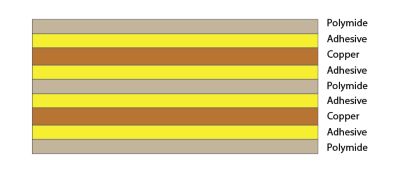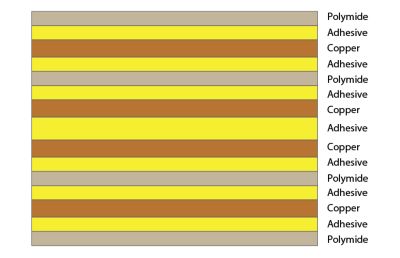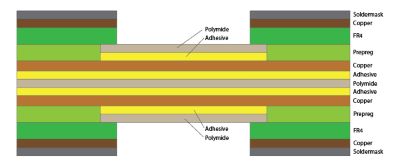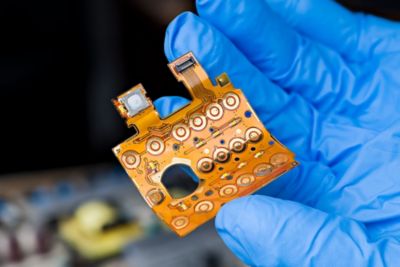-
United States -
United Kingdom -
India -
France -
Deutschland -
Italia -
日本 -
대한민국 -
中国 -
台灣
-
Ansys는 학생들에게 시뮬레이션 엔지니어링 소프트웨어를 무료로 제공함으로써 오늘날의 학생들의 성장을 지속적으로 지원하고 있습니다.
-
Ansys는 학생들에게 시뮬레이션 엔지니어링 소프트웨어를 무료로 제공함으로써 오늘날의 학생들의 성장을 지속적으로 지원하고 있습니다.
-
Ansys는 학생들에게 시뮬레이션 엔지니어링 소프트웨어를 무료로 제공함으로써 오늘날의 학생들의 성장을 지속적으로 지원하고 있습니다.
연성회로기판(PCB)이란 무엇이며 어떻게 제조되는가?
연성 인쇄 회로 기판(PCB)은 점점 인기를 얻고 있는 전자 상호 연결의 한 유형입니다. 회로에서 구성품을 연결하는 이 방식은 설계 옵션을 제공하고 견고성을 높입니다. 연성 전자장치, 연성 회로 기판, 연성 인쇄 회로(FPC) 또는 플렉스 회로라고도 하는 이 회로의 전도 경로는 일반적으로 폴리이미드, PEEK 또는 폴리에스터로 만들어진 유연한 플라스틱 기판 위에 구축되며 구성품은 노출된 구리 패드에 납땜됩니다.
연성 PCB는 단일, 이중 또는 다중 레이어의 전도성 구리 회로를 가질 수 있습니다. 기판이 연성이기 때문에 패키징에서 강성 PCB에 비해 장점이 있습니다.
연성 PCB 시장은 2023년 수익이 218억 달러로 성장하여 모든 유형의 PCB에 대한 730억 달러 시장의 30%를 차지했습니다. 플렉스 회로는 강성 기판과 동일한 전자 부품을 지원하며, 널리 사용되는 기술인 만큼 전자 조립품의 제조 공정, 재료 및 패키징이 플렉스 회로 기판 구성을 결정합니다.
차이점은 기판의 굽힘성입니다. 설계자가 이러한 요소를 파악해야 문제를 피하고 회로 설계를 실현하는 이 (문자 그대로) 유연한 방식의 이점을 활용할 수 있습니다.
연성 PCB의 구조 이해
연성 PCB는 전도, 절연 또는 결합에 사용되는 여러 레이어의 재료로 구성됩니다. 전도 레이어의 수에 따라 FPC는 단일, 이중 또는 멀티레이어 유형으로 나눌 수 있습니다.
이러한 레이어 외에도 연성 PCB의 다른 중요한 특징으로는 절연 재료의 외부 커버 레이어를 제거하여 솔더 패드와 레이어 사이의 전도에 사용되는 구리 도금 구멍(비아라고 함)을 노출시키는 영역입니다.

단일 레이어 구성은 연성 유전체 기판, 접착 레이어, 전도 레이어, 또 다른 접착 레이어, 연성 유전체 커버 레이어로 구성됩니다.

이중 레이어 구성은 기본 유전체의 양쪽에 접착제, 도체, 접착제 및 유전체가 쌓인 구조입니다. 비아 역할을 하는 도금 관통 구멍이 추가되어 전도층을 연결합니다.

멀티레이어 구성은 이 라미네이트 구조를 필요한 만큼의 레이어로 쌓고 비아를 관통 또는 블라인드 처리할 수 있습니다.

강성 PCB 내부에 레이어를 임베드하여 강성 PCB에 연성 PCB를 부착할 수도 있습니다. 이 구성을 리지드-플렉스 PCB라고 하며, 각 형식을 동시에 활용하거나 와이어 또는 와이어 하네스 대신 플렉스 회로로 여러 개의 강성 PCB를 연결할 수 있는 방법이기도 합니다.

연성 PCB의 장점은 고밀도 상호 연결(HDI)을 사용하는 설계에도 적합하다는 점입니다. HDI를 사용하면 PCB 설계에서 유연한 부분을 가지면서 더 컴팩트한 회로, 더 얇은 레이어, 마이크로 비아를 갖춘 리지드 플렉스 PCB를 만들 수 있습니다.
폼 팩터가 작기 때문에 HDI는 복잡하거나 패키징이 까다로운 응용 분야에 적합한 선택입니다. 패키징이 촘촘하기 때문에 연성 PCB는 더 많은 설계 옵션을 제공하기 위해 선호되는 선택일 뿐만 아니라 HDI를 다른 구성품에 연결하는 유일한 방법이기도 합니다.
반대로 칩이나 섬세한 센서와 같은 구성품용 경성 보드가 구성에 필요한 경우, FPC에 연결된 HDI에 해당 구성품을 배치할 수 있습니다.
다음은 연성 PCB의 스택업을 만드는 데 사용되는 구성품에 대한 간략한 설명입니다.
연성 유전체 레이어
연성 PCB의 기본 재료입니다. 어셈블리의 특징적인 물리적 특성, 특히 최종 구조의 모양과 강성을 정의합니다. 기판은 일반적으로 폴리이미드(PI)로 만들어지는데, 이는 PI의 유연성, 내화학성 및 유리한 열적 특성 때문입니다.
또 다른 인기 소재는 폴리에스테르(PET)이지만 특수한 속성이 필요한 경우 다른 유전체 폴리머를 사용할 수 있습니다. 이 레이어의 두께는 일반적으로 12μm에서 125μm입니다. 레이어가 두꺼울수록 구조가 더 단단해집니다. 기판은 전도 레이어 위의 핵심 레이어와 절연 레이어(강성 PCB의 솔더 마스크와 유사)의 역할을 합니다.
접착 레이어 접합
전도 레이어가 베이스 레이어에 직접 접합되지 않기 때문에 라미네이트 구조는 접착 레이어를 사용합니다. 설계자는 접착 재료의 접합 강도와 최대 온도에 주의를 기울여야 합니다. 이러한 값은 기계적 부하 및 열부하를 제한하기 때문입니다.
전도 레이어
라미네이트 스택의 전도 레이어는 일반적으로 구리로 만들어집니다. 그러나 필요한 경우 다른 전도성 금속을 사용할 수 있습니다. 대부분의 응용 분야에서 구리 레이어는 기판에 접합된 포일로 만든 다음 에칭되어 원하는 회로를 만듭니다. 금속 포일은 또한 다양한 두께로 제공될 수도 있습니다. 동박(구리 포일)은 일반적으로 압연하여 연동박을 만들거나 전착합니다. 전도성 잉크를 사용하여 트레이스를 인쇄할 수도 있습니다.
도금된 구리
설계에 레이어를 통한 연결이 필요한 경우, 라미네이트에 구멍을 뚫고 구리로 도금하여 비아를 만듭니다.
표면 마감
구리와 같이 전도성이 높은 금속의 한 가지 단점은 산화되기 쉽다는 것입니다. 이를 방지하기 위해 얇은 재료 코팅을 표면 마감으로 적용합니다. 이러한 재료는 납땜 접합에도 유용합니다. 표면 마감의 가장 일반적인 유형은 ENIG(Electroless Nickel/Immersion Gold), OSP(Organic Solderability Preservative), 이머전 실버, 이머전 틴, 이머전 골드입니다.
보강재
가끔, 연성 PCB의 특정 영역에 기계적 강성이 필요한 경우가 있습니다. 보강재는 FR4(강성 PCB의 소재) 조각 또는 더 두꺼운 폴리이미드 레이어일 수 있습니다. FR4 보강재의 일반적인 용도는 강성 커넥터를 지지하거나 회로에 납땜된 대형 부품 아래에서 구부러지는 것을 막아 납땜 접합부의 응력을 줄이는 것입니다.
연성 PCB의 장점
연성 PCB를 사용하면 많은 이점이 있습니다. 기판의 기계적 특성 및 열적 특성은 다양한 설계 및 성능 기회를 열어줍니다. 대부분의 장점은 회로 기판 재료의 유연성과 레이저 절단으로 복잡한 형상을 쉽게 만들 수 있는 능력에서 나옵니다. 또한 기판 재료는 강성 PCB에 사용되는 재료보다 열적 특성이 더 우수한 경우가 많습니다. 가장 중요한 이점은 아래에 나와 있습니다.
효율적인 공간 사용
연성 PCB는 더 얇고 복잡한 모양으로 쉽게 절단할 수 있으며 내부에 배치되는 장치의 모양에 맞게 구부릴 수 있습니다. 또한 특히 리지드 플렉스 회로에서는 부품을 서로 다른 방향으로 배치하면서도 연결할 수 있습니다.

생산된 연성 PCB
유독한 환경에서도 견고함
플렉스 설계에 사용되는 폴리머 재료는 유독한 화학 물질에 내성이 있습니다. 또한 고온을 견딜 수 있으며 강성 PCB보다 열 방출 기능이 뛰어납니다.
내구성 향상
플렉스 회로를 적절히 설계하면 전도성 회로의 고장 없이 많은 수의 굽힘 주기를 견딜 수 있습니다.
충격 및 진동에 대한 저항
강성과 질량이 낮기 때문에 연성 PCB를 사용하는 전자 어셈블리를 통해 유입되는 에너지와 전달되는 에너지가 적습니다. 또한 이 소재는 충격과 진동으로 인한 상당한 수준의 변형을 견딜 수 있습니다.
질량 감소
1그램도 중요한 응용 분야에서 연성 PCB는 강성 보드보다 더 적은 질량으로 전자 회로를 제공합니다.
조립 간소화
기존의 배선이나 와이어 하네스를 교체할 때 연성 PCB를 사용하면 조립 비용을 크게 절감할 수 있습니다. 또한 나사나 클램프로 고정할 필요가 없으며 제자리에 접착하거나 인클로저 내부에 떠 있는 상태로 둘 수 있습니다.
연성 PCB의 과제
얼핏 보기에 연성 또는 리지드-플렉스 PCB를 사용해야 하는 이유는 많습니다. 그러나 많은 애플리케이션이 유연 기판의 이점을 누리지 못하기 때문에 표준 리지드 회로 기판이 여전히 전자 회로의 주요 플랫폼입니다. 다음은 연성 PCB의 가장 중요한 과제에 대한 분석입니다.
비용
연성 PCB의 재료 및 제조 비용은 일반적으로 사용하는 강성 PCB보다 높습니다. 이러한 비용은 플렉스 회로가 대중화됨에 따라 결국 감소할 것입니다. 그러나 유연한 소재를 쌓아 올리는 것이 어렵고 기본 재료의 가격이 높기 때문에 비용은 계속 높아질 것입니다.
부품과 신호선로 아래의 굽힘
연성 PCB의 가장 큰 장점은 단점도 될 수 있습니다. 단단한 부품 아래에서 재료를 구부리면 부품을 전도 레이어에 부착하는 납땜에 상당한 부담이 생길 수 있습니다. 보강재가 이 문제에 대한 좋은 해결책이지만 보강재를 추가하면 비용이 증가합니다.
트레이스 라우팅에 응력 집중을 고려하지 않으면 납땜 조인트에 부담을 줄 수 있는 동일한 굽힘으로 인해 전도성 회로에 고장을 일으킬 수도 있습니다. 전자 신뢰성 시뮬레이션을 적절하게 사용하면 설계에서 문제 영역을 식별하고 과도한 굽힘으로 인한 고장을 방지하도록 PCB 설계를 유도할 수 있습니다.
플렉스 PCB 제조의 도전 과제
강성 PCB의 구성과 배치를 자동화하는 것은 매우 쉽습니다. 얇고 유연한 회로는 제조 공차 내에서 유지하기가 더 어렵고, 부품 배치와 납땜을 자동화하기가 더 어렵습니다.
신호 무결성 문제
신호 무결성이란 전기 신호가 성능 저하나 왜곡 없이 회로를 통과할 수 있는 능력을 말합니다 연성 PCB에 사용되는 얇은 소재는 한 회로에서 다른 회로로 전자기 간섭(EMI)을 허용할 수 있습니다. 또한 기판이 구부러지면 신호 반사의 변화와 임피던스 불일치가 발생할 수 있습니다. 이러한 과제는 신호 무결성 시뮬레이션을 통해 구동되는 우수한 설계 관행과 적절한 라우팅을 따르면 극복할 수 있습니다.
연성 PCB의 일반적인 응용 분야
연성 PCB는 기술의 장점이 높은 비용을 능가하는 다양한 응용 분야에 적용되고 있으며, 최적화된 설계를 통해 문제를 피할 수 있습니다.
연성 PCB의 가장 일반적인 응용 분야는 소비자용 전자 기기입니다. 회로가 기기 모양에 맞게 조정되어야 하지만 크기는 최대한 작아야 합니다. 계산기에서 휴대폰에 이르기까지 설계자들은 유연한 전자장치를 신중하게 사용하여 성능과 미적 측면의 균형을 맞추고 있습니다.
고가의 와이어 하네스를 진동 및 내열성이 뛰어나 좁은 모서리에도 맞는 유연한 PCB로 교체하면 많은 자동차 애플리케이션에 이상적인 기술이 적용됩니다. 자동차 설계자에게 또 다른 장점은 같은 평면에 있지 않은 부품을 서로 특이한 각도로 커넥터에 연결할 수 있는 기능입니다. 이와 동일한 장점으로 인해 산업용 센서 개발자들도 유연한 PCB를 사용하여 부품을 효율적으로 연결하고 센서가 모니터링하는 산업 기계의 열과 진동에 견뎌낼 수 있습니다.
의료 기기, 특히 웨어러블 기기도 연성 PCB를 사용합니다. 이렇게 하는 것이 웨어러블 기기의 무게와 크기 제약과 인체의 유기적 모양에 맞아야 하는 필요성을 해결하는 이상적인 방법입니다. 의료 기기가 더 작아지고 강력해짐에 따라 기업은 연성 또는 리지드-플렉스 PCB를 선택할 것입니다.
연성 PCB의 미래
전자 산업의 여러 추세로 인해 연성 PCB의 채택이 확대되고 있습니다. 보다 작은 패키지에 더 많은 기능을 담으려는 지속적인 노력으로 인해 설계자가 평평한 강성 PCB에서 벗어나 장치 내부에 회로를 맞춰 장착하게 될 것입니다.
연성 기술 공급업체는 향상된 성능을 제공하기 위해 새로운 재료 사용을 고려하고 있습니다. 제조업체가 더 나은 제조 공정과 더 큰 자동화를 구현함에 따라 채택이 증가하면 가격이 낮아지고 생산 속도가 빨라질 것입니다. 연성 PCB 제조를 제안하는 공급 업체가 늘어날 것이며 계약 제조업체는 연성 PCB를 장치에 조립하는 역량을 늘릴 것입니다.
유연한 디스플레이와 점점 더 작아지는 산업용 전자장치 및 가전제품의 성장은 연성 PCB이의 채택을 이끌어낼 분야 중 하나입니다. 이러한 기술에는 연성) 회로를 사용해야 합니다. 마찬가지로, 점점 더 얇은 케이스에 더 많은 기능을 갖춘 컴퓨터와 모바일 기기를 요구하는 추세는 이 기술을 계속 발전시킬 것입니다. 마지막으로, 자동차가 전기화되면서 더 좁고 혹독한 환경에서 더 유연한 회로가 필요할 것입니다.
이러한 미래를 실현하기 위해서는 연성 PCB 및 리지드-플렉스 PCB로 패키지를 개발하는 엔지니어'가 상충되는 특성의 균형을 맞춰야 하는 경우가 많습니다. Ansys 시뮬레이션 도구 제품군을 배포하면 설계 옵션을 탐색하고 최적의 설계를 추진할 수 있습니다. 연성 PCB를 지원하기 위해 배포되는 가장 일반적으로 사용되는 Ansys 도구 중 일부는 다음과 같습니다.
- Ansys Maxwell®: 저주파 전자기학 시뮬레이션을 위한 최고의 표준입니다. PCB 설계자 및 가전제품 엔지니어는 전자기적으로 유도된 기계적 진동과 유도 결합 EMI/EMC와 같은 문제를 해결하기 위해 Maxwell 소프트웨어를 사용합니다.
- Ansys HFSS™: 고주파 전자기학 시뮬레이션을 위한 최고의 표준이며, 엔지니어는 HFSS 소프트웨어를 사용하여 연성 PCB에 구축된 비용 효율적인 고성능 회로 레이아웃과 안테나를 개발합니다.
- Ansys SIwave™: PCB 전자기 시뮬레이션에 특화된 SIwave 소프트웨어는 형상을 가져오고 신호 무결성(SI), 전력 무결성(PI), 전자기 간섭(EMI), 임피던스 및 크로스토크를 모델링하는 빠르고 강력한 방법을 제공합니다.
- Ansys Icepak®: PCB 열 시뮬레이션 및 냉각 설계를 위한 업계 표준으로, PCB 시뮬레이션을 위해 구축된 사용자 인터페이스에 첨단 다중물리 솔버가 포함되어 있습니다.
- Ansys Sherlock™: Sherlock을 사용하면 다양한 연성 PCB 파일 형식을 가져올 수 있으며 재료, 형상, 부품 정보용으로 파일을 전처리할 수 있는 다양한 옵션을 제공합니다. 일반적인 시나리오는 심층적인 열-기계 분석을 위해 편집된 연성 PCB 파일을 Sherlock 소프트웨어에서 Ansys Mechanical™ 소프트웨어로 내보내는 것입니다.
- Ansys Mechanical: Mechanical 소프트웨어는 Sherlock 도구와 함께 연성 PCB의 신뢰성 및 열-기계적 측면을 분석하는 강력한 솔루션을 제공합니다.
가장 까다로운 연성 PCB 설계 중 상당수가 Ansys 시뮬레이션으로 구동되는 데에는 그만한 이유가 있습니다. 이 도구는 사용하기 쉽고, 함께 작동하며, 보다 실용적인 정보를 제공하기 때문입니다. 이 문서에 있는 링크를 살펴보거나 당사에 연락하여 귀사의 요구 사항과 과제에 대해 알려주시면 당사의 엔지니어가 올바른 솔루션을 찾을 수 있도록 도와드립니다.
관련 리소스
시작하기
엔지니어링 과제에 직면하고 있다면우리 팀이 도와드리겠습니다. 풍부한 경험과 혁신에 대한 헌신을 가지고 있는 우리에게 연락해 주십시오. 협력을 통해 엔지니어링 문제를 성장과 성공의 기회로 바꾸십시오. 지금 문의하기










